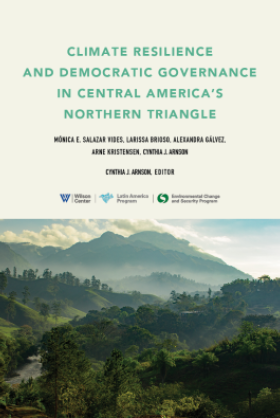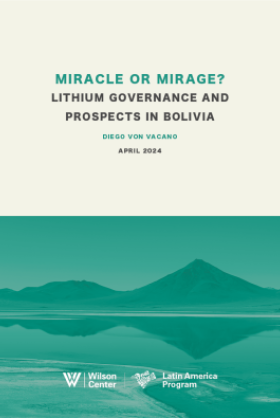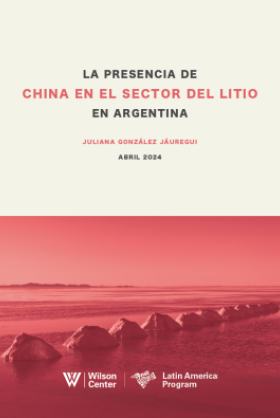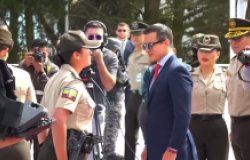Rethinking the U.S.-Mexico Border
Andrew Selee, Director, Mexico Institute, Woodrow Wilson Center; Tonatiuh Guillén, President, El Colegio de la Frontera Norte; Carlos de la Parra, Professor, El Colegio de la Frontera Norte; Jerrold D. Green, President, Pacific Council on International Policy, Robert Bonner, former Commissioner, U.S. Customs and Border Protection; Andrés Rozental, former Deputy Foreign Secretary, Government of Mexico; Roberta Jacobson, Deputy Assistant Secretary of State for Canada and Mexico; Arturo Sarukhan, Ambassador of Mexico; Carlos Gutierrez, former Secretary of Commerce
Overview

The U.S.-Mexico border needs a new paradigm, one that leverages the region's synergies to pull both countries out of recession, improve regional security, and enhance the lives of residents on both sides, speakers said at the conference, "Rethinking the U.S.-Mexico Border."
Speakers articulated new visions for border relations contained in two policy-focused reports publicized at the conference. "Strategic Guidelines for the Competitive and Sustainable Development of the U.S.-Mexico Transborder Region," issued by the Border Governors Conference and jointly prepared by the Woodrow Wilson Center Mexico Institute and El Colegio de la Frontera Norte (COLEF), offers a long-term vision and identifies policy options to make the region more economically competitive and environmentally sustainable, as well as more secure, more equitable, and more livable. "Managing the United States-Mexico Border: Cooperative Solutions to Common Challenges," a report of a binational task force commissioned by the Pacific Council on International Policy (PCIP) and the Mexican Council on Foreign Relations/Consejo Mexicano de Asuntos Internacionales (COMEXI), envisions a binational "system of border management," focused on enhancing cross-border trade, environmental stewardship, and security collaboration.
The conference consisted of presentations of both reports and remarks from U.S. and Mexican government officials.
Strategies for a Competitive and Sustainable Border
Dr. Tonatiuh Guillen, president, COLEF, emphasized the significance of the border as a region and in terms of the binational relationship. It is at the border where the United States and Mexico meet and where the principal issues that shape their relationship most visibly play out. The bulk of two-way trade takes place at land crossings along the nearly 2,000-mile border, and taken collectively the 10 U.S. and Mexican border states total more than 80 million residents, representing the world's third-largest economy. Yet sustained policy coordination among the states and between their respective federal governments has historically been lacking, leaving unilateral decision-making in the hands of Washington and Mexico City.
Thus an impetus behind the report, said Dr. Carlos De La Parra, Research Professor, Urban and Environmental Studies Department, COLEF, was to gather viewpoints from border-region stakeholders to inform policy considerations at the state and federal levels, as well as to create a roadmap for the region's future growth. De La Parra also noted that the report's findings represented a negotiation among the 10 border states, whose representatives signed onto a related declaration at the Border Governors Conference in Monterrey, N.L., in September 2009.
Cooperative Solutions for Common Problems
Hon. Robert Bonner, PCIP-COMEXI task force co-chair, emphasized the need to improve border security at and between ports of entry to better facilitate trade and to weaken and defeat organized crime syndicates and drug trafficking organizations (DTOs). Institutional, technological, and infrastructure advancements hold the promise of improving security, he said. The Mexican customs agency should be made more organizationally compatible with its U.S. counterpart, to enable better communication. Advanced detection technologies, as well as intelligent risk management strategies, should also be deployed, to decongest ports of entry, improving security, he said. Across the border, processing capacities should be increased through the construction of new ports of entry, the expansion of existing facilities, and the creation of specialized lanes for frequent and vetted crossers.
Amb. Andres Rozental, PCIP-COMEXI task force co-chair, said the report was a conscious attempt to examine the border from beyond the perspective of the national capitals. He listed the report's principal recommendations, which were broken out in near- and long-term projections in the principal issue areas of security, trade facilitation, economic development, the environment, water, and migration.
Managing the U.S.-Mexico Border
Security and prosperity are complementary goals, Hon. Carlos M. Gutierrez, former Secretary of Commerce and Member, Wilson Center Board of Trustees, said. "We have to do both. We have to secure the border and maintain commerce," he said. Gutierrez explained the magnitude of U.S.-Mexico trade. He said that Mexico was the United States' second-leading export destination, and that Mexico exports approximately US$200 billion in goods and services to the United States. One-third of total U.S. trade, he said, is with Canada and Mexico. "(The North American Free Trade Agreement) is about a US$1 trillion relationship," he said.
Jayson P. Ahern, Acting Commissioner, Customs and Border Protection (CBP), said the right balance is needed between security and trade. He discussed advances to improve border security, including CBP's Customs Trade Partnership Against Terrorism (C-TPAT). C-TPAT rewards participating companies with expedited crossings in exchange for their implementing security measures at the point of origin and along the supply chain. Ahern nevertheless indicated that processes and technologies need to be continually improved. Regarding port infrastructures, Ahern noted that recent stimulus spending has enabled upgrades. He tentatively credited such improvements, along with the use of detection technologies, aircraft, and physical barriers, with causing a 23-percent decline in apprehensions of illegal border crossers. (The rate of apprehensions correlates with the rate of illegal border crossing attempts.)
Improvements at the border to benefit the nation's security are made possible through a combination of facilities and infrastructure upgrades, better personnel training, and enhanced technology, through partnership with Mexico, Ahern said.
Roberta Jacobson, Deputy Assistant Secretary for Mexico, Canada, and NAFTA, U.S. State Department, noted that circumstances are favorable for the advancement of a bilateral border agenda. Both countries recognize the border as an important place for the strengthening of the binational relationship, and the concept of shared responsibility has been received favorably by citizens in both countries. This is true especially regarding contraband trafficking; people understand "whether it's drugs coming north or bulk cash and arms going south." Jacobson suggested that what benefits the border region policywise benefits the interior. "There is very little useful distinction between bilateral foreign policy and border policy." Mexico and the United States are collaborating on a variety of border issues: from water management to law enforcement cooperation to H1N1 virus containment, she noted.
"The two countries are working on such a broad sweep of issues that we can drill down and make real progress," she said. The deputy assistant secretary said the two border studies make an important contribution. The studies remind government actors that trade versus security is "not a zero-sum game," and that the two policy areas can complement one another.
A New Relationship at the Border
Amb. Arturo Sarukhan said that old paradigms for managing the border are outmoded and ineffective partly because of conceptions about national sovereignty. He said Mexico and the United States should institute a system of joint border management that could become a cornerstone for the binational relationship. However a great challenge that Mexico faces is overhauling its customs agency from revenue-generator to border security force.
Security
Sarukhan stressed the need for flexibility in binational security cooperation efforts, such as those under the auspices of the Merida Initiative. "A corseted approach to security is a bad approach," he said. Flexibility is needed to adjust to continuously evolving needs not previously foreseen, such as the need for more rotor versus fixed-wing aircraft in a given year or for more maritime vessels in another. Authorities in both countries need to be able to respond quickly to changes in the modus operandi of DTOs, he said, lest they lose to these criminals whose ability to change tactics and thwart enforcement is unencumbered by time-consuming bureaucratic processes.
Responding to a question on U.S. arms trafficking in the question-and-answer session, Sarukhan drew a correlation between the lapse of the federal assault weapons ban in 2004 and an increase in assault weapon seizures in Mexico. But he said that the southern border is problematic too, as almost all hand grenades that turn up in Mexico have been illegally trafficked from Guatemala or Belize.
Trade
Sarukhan stressed that security and prosperity are not at odds with one another but rather are complementary. In the question-and-answer session, the ambassador said that the Punta Colonet megaport project near Ensenada and associated railroad projects represent opportunities to advance binational economic integration. Also in the session, Sarukhan said that preclearance of U.S. travelers will increase tourism revenues for Mexico and that Mexico is awaiting the designation of new CBP leadership prior to moving forward on the initiative. (Preclearance involves U.S. customs agents processing returning U.S. travelers inside Mexico, as a way to facilitate faster arrivals at U.S. ports.)
Drafted by Robert Donnelly, Program Associate, Mexico Institute
Andrew Selee, Director, Mexico Institute. Ph: (202) 691-4088
Hosted By

Mexico Institute
The Mexico Institute seeks to improve understanding, communication, and cooperation between Mexico and the United States by promoting original research, encouraging public discussion, and proposing policy options for enhancing the bilateral relationship. A binational Advisory Board, chaired by Luis Téllez and Earl Anthony Wayne, oversees the work of the Mexico Institute. Read more
Thank you for your interest in this event. Please send any feedback or questions to our Events staff.










